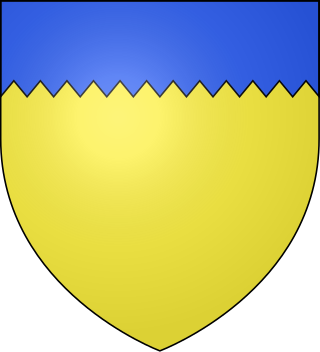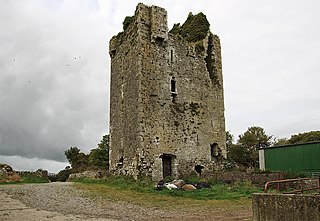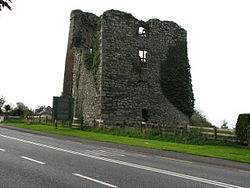
New Ross is a town in southwest County Wexford, Ireland. It is located on the River Barrow, near the border with County Kilkenny, and is around 20 kilometres (12 mi) northeast of Waterford. In 2022 it had a population of 8,610 people, making it the fourth-largest town in the county.

Viscount Mountgarret is a title in the Peerage of Ireland.

Ballyragget is a small town on the river Nore in the north of County Kilkenny in Ireland. Ballyragget is on the N77 road, 18 km (11 mi) north of Kilkenny. As of the 2016 census, it had a population of 1,082 people.

The N30 road is a national primary road in Ireland. It connects the N25 road and M11 motorway, providing a link running east-northeast through County Wexford, between New Ross and Enniscorthy. This provides for a more direct national route between the two towns, as the N25 and N11 both run to Wexford town, eastwards from New Ross and southwards from Enniscorthy respectively.
Richard Butler, 1st Viscount Mountgarret was the son of Piers Butler, 8th Earl of Ormond and Lady Margaret Fitzgerald. He married his half first cousin Eleanor Butler, daughter of Theobald Butler of Polestown, the illegitimate brother of the 8th Earl of Ormond. He was created 1st Viscount Mountgarret in 1550.

Adamstown is a village in County Wexford, Ireland. It is about 24 km (15 mi) north-west of Wexford, 20 km (12 mi) east of New Ross, and 20 km (12 mi) south-west of Enniscorthy. The village is in a townland and civil parish of the same name.

Goresbridge is a small village located in the east of County Kilkenny, in the province of Leinster, Ireland. Goresbridge is named after a 1756 bridge, built by Colonel Ralph Gore, which provides a crossing of the River Barrow between County Kilkenny and County Carlow in the South-East region.
Richard Butler, 3rd Viscount Mountgarret (1578–1651) was the son of Edmund Butler, 2nd Viscount Mountgarret and Grany or Grizzel, daughter of Barnaby Fitzpatrick, 1st Baron Upper Ossory. He is best known for his participation in the Irish Confederate Wars on behalf of the Irish Confederate Catholics.
Patrick Barrett was an Irishman who held religious and secular high offices in Ireland.
Raheen is a townland and village in County Wexford, Ireland. It lies 27 km from Wexford, 11 km from New Ross, and 23 km from Enniscorthy.

Mount Loftus is a country estate in the civil parish of Powerstown in County Kilkenny, Ireland. It was originally home to the Loftus baronets, the baronetcy being extinct since the death of the third baronet in 1864. The original 18th century manor house was demolished in 1906. The current house on the estate, built in the early 20th century, was rebuilt from staff accommodations after a fire in the 1930s. This house, and several of its outbuildings, are included on Kilkenny County Council's Record of Protected Structures.
Pierce Somerset Butler was an Irish politician in the United Kingdom House of Commons.

Butler is the name of a noble family whose members were, for several centuries, prominent in the administration of the Lordship of Ireland and the Kingdom of Ireland. They rose to their highest prominence as Dukes of Ormonde. The family has produced multiple titles such as Baron Cahir, Baron Dunboyne, Viscount Ikerrin, Viscount Galmoye, Viscount Mountgarret, Viscount Thurles, Earl of Carrick, Earl of Kilkenny, Earl of Ormond, Earl of Ossory, Marquess of Ormonde and Duke of Ormonde. Variant spellings of the name include le Boteler and le Botiller. The Butlers were descendants of Anglo-Norman lords who participated in the Norman invasion of Ireland in the 12th century. The surname has its origins in the hereditary office of "Butler (cup-bearer) of Ireland", originating with Theobald Walter, 1st Chief Butler of Ireland. The arms of later family members depicted three cups in recognition of their original office.

Moycarkey Castle, in Moycarky townland, County Tipperary, is a tower-house located inside a large rectangular bawn with round flanking towers at the north-eastern and south-western corners. The entrance to the tower-house is protected by a double murder-hole.

Clonmines is a civil parish and townland in the Bannow Bay area of County Wexford, Ireland, the site of "the finest example in Ireland of a deserted medieval borough". It is situated in the barony of Shelburne, southwest of Wellingtonbridge on the northwest shore of Bannow Bay. The parish of Clonmines contains the townland of the same name and the smaller townland of Arklow, with respective areas of 1,258 acres (509 ha) and 127 acres (51 ha).

Johnstown Castle is a Gothic Revival castle located in County Wexford, Ireland.

Clomantagh Castle is a 15th-century tower house located near Freshford, County Kilkenny, in Ireland. Originally constructed in the 1430s, additional buildings and outbuildings were added in the subsequent centuries - including a connected 19th century farmhouse. Carvings on the castle's walls include a Sheela na gig relief.
Saint Nissen was an early Christian convert who was abbot of a monastery in County Wexford, Ireland.

Robert Whittey, or Whitty (1370–1458) was a Bishop of Ferns in Ireland, notable for his long tenure of the see, and his great age at death.

Slade is a small village and townland in County Wexford, Ireland. The townland, which has an area of approximately 1 square kilometre (0.4 sq mi), sits on the Hook Peninsula and had a population of 52 people as of the 2011 census. Slade has historically been a fishing port, and was defended by Slade Castle from the late 15th century. In the south of the townland, there is evidence of an earlier ringfort. The harbour in Slade village was extended in the mid-19th century and built upon piers dating from at least the 17th century. A salt-house was built here in the 17th century, to salt (preserve) the fish landed in the harbour. There is a small beach next to the harbour, and Hook Sub Aqua Club is based nearby.















